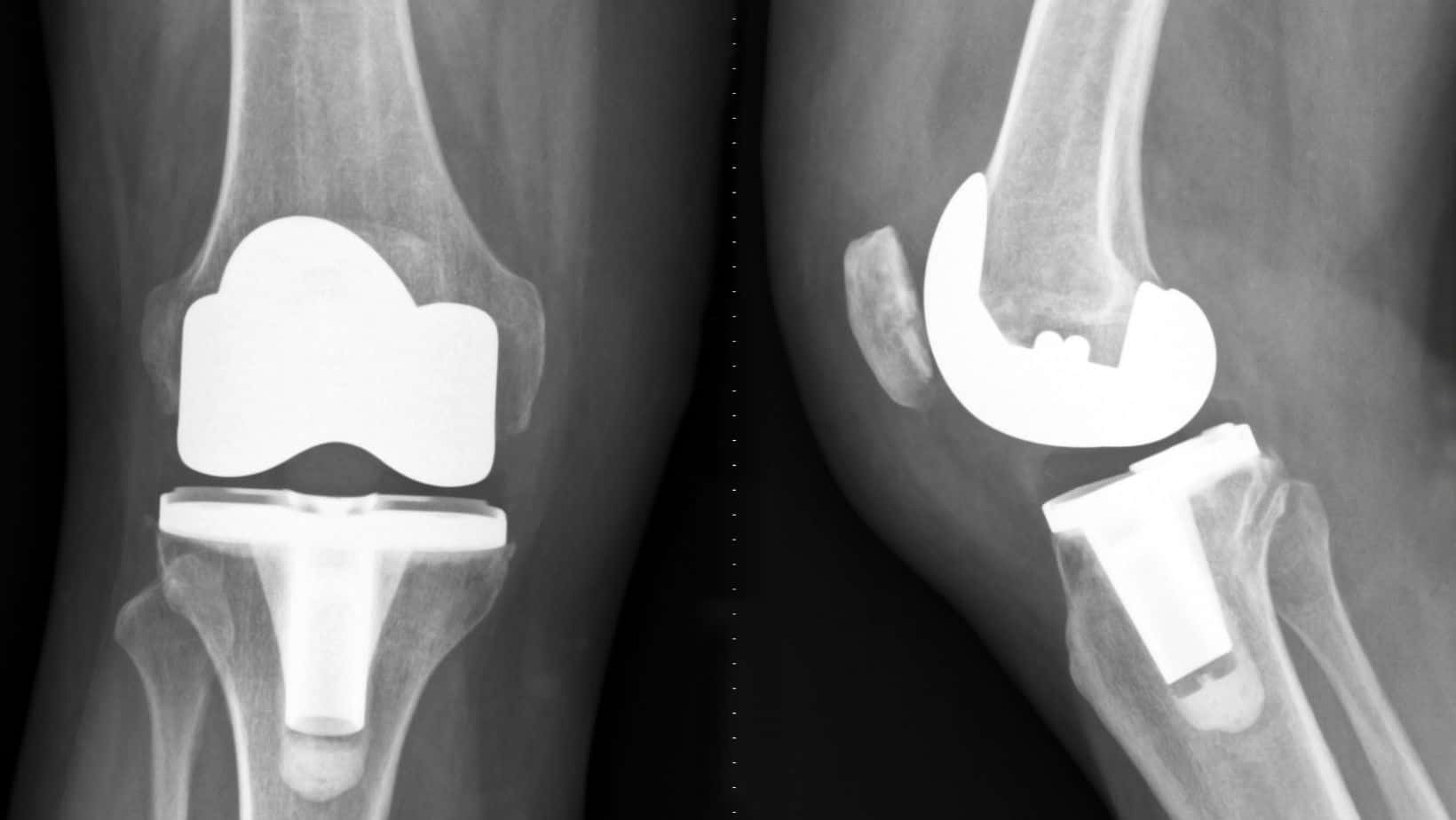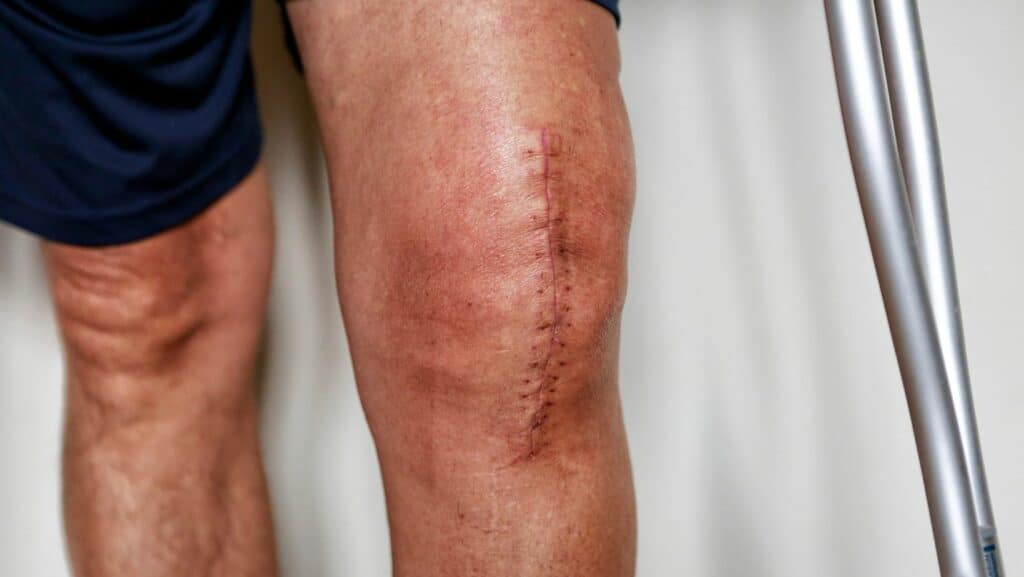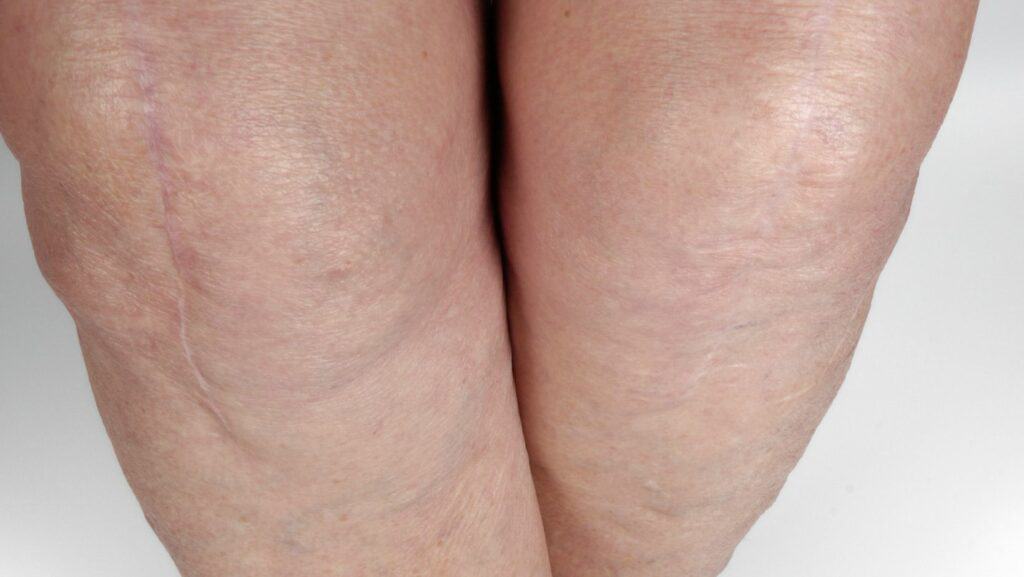Muscles of the Knee
Read More >
Knee replacement surgery is the removal of damaged bone and cartilage and a synthetic replacement. At the knee, there is a total knee replacement (TKR) option where the whole knee joint is replaced, and a partial knee replacement (PKR) option where one-half of the knee is replaced, either the medial or lateral compartment. Less commonly the patellofemoral joint can be replaced and this can also be referred to as a partial knee replacement. Typically the synthetic replacement is made out of a combination of metal, plastic, and ceramic.

On this knee replacement x-ray image, you can see a full knee replacement. The top component in the femur and lower component in the tibia are clear to see on an x-ray image. Modern techniques aim to take away as little of the original bone as possible and replace it with a correctly sized prosthesis for the individual. A post knee replacement x-ray is usually taken to ensure the correct positioning, and sometimes a follow-up knee replacement x-ray ray is taken in the weeks after surgery to check the alignment remains as it should be.
One of the relatively minor disadvantages of knee replacement surgery is the sensation and aesthetics of a large scar at the front of your knee. As you can see in this photo (left) of a knee replacement scar, the scar is large. This image shows a scar that is likely In the first 3 or 4 weeks after surgery. After surgery and for the first 6-8 weeks at least, the scar will feel tight and might be painful as it is in the healing phase. This will improve with the correct treatment of exercises, massage, and stretches, which will reduce the tightness of the scar. Aesthetically it will take several months to a year to reduce in appearance, most knee replacement scars reduce significantly in width and fade in colour, and will be more subtle a year down the line. If the surgeon has made a neat cut and kept it as short as possible, as well as if you have had no infection of the scar during your recovery, it is likely to fade well to a faint thin line down the front of your knee as you can see in this photo of a knee replacement scar (right).


Whilst knee replacement surgery is a brilliant surgery overall, the decision to have the surgery should not be taken lightly as it is major surgery and a replacement knee is not the same as the original. There will be permanent restrictions after knee replacement surgery that need to be discussed between the surgeon and patient to ensure that an informed decision is made and that surgery is the best option for the patient and that the time is right to proceed with surgery.
Permanent restrictions after knee replacement are mostly linked to preserving the life of the prosthetic. While you might be physically able to return to high-impact sports such as running and skiing you should carefully consider your options. With these activities, you might consider how much you do of them and how you can make these sports less stressful for your knee. Many people go back to running but it might be wise to stick to short runs, less frequently, on soft ground and with good shoes, then road marathons every other week. In all cases, you should discuss your options and goals with your surgeon and physical therapist.

In many cases, both knees are painful and restricted when it comes time to discussing surgery. The choice usually then comes down to which knee to have surgery on first rather than having a double knee replacement simultaneously. On occasion, both knees will be operated on at the same time, but this is rare, and in almost all cases not advisable. The recovery after a double knee replacement is much harder as both legs are in pain. Generally, it is advised to have a minimum of 3 months between surgeries but 6 months is preferable.

Most people feel able to return to driving 6-8 weeks after knee replacement surgery. However, there are two points to consider regarding driving after knee replacement surgery, car insurance, and functional ability. Clearly, you need to be able to drive safely before considering getting behind the wheel. But you must check with your insurer if your policy covers you. Most car insurance will not cover you to drive for the first 6-8 weeks after surgery.
The overwhelming reason for, and feedback after surgery is that there is less knee pain after replacement. The vast majority of people are happy with the outcome of their knee replacement surgery for a decade or longer after the procedure. Statistics show 80-90% report less knee pain after replacement, for both total knee replacement and partial knee replacement. As well as the benefit of pain relief, joint stiffness and mobility are also improved in almost all cases of replacement surgery.
The other resounding positive of knee replacement surgery is a functional improvement. Most people are satisfied with how much walking after knee replacement they can do. Restriction of walking is often one of the main reasons for opting for surgery in the first place, with many people reporting a decline in walking distance and speed in the years prior to surgery.

This is not medical advice. We recommend a consultation with a medical professional such as James McCormack. He offers Online Physiotherapy Appointments for £45.
Related Articles:
Knee Arthritis – Knee Bone on Bone – Best Running Shoes for Knee Arthritis – Top 5 Mistakes After Knee Replacement – Chondromalacia Patella